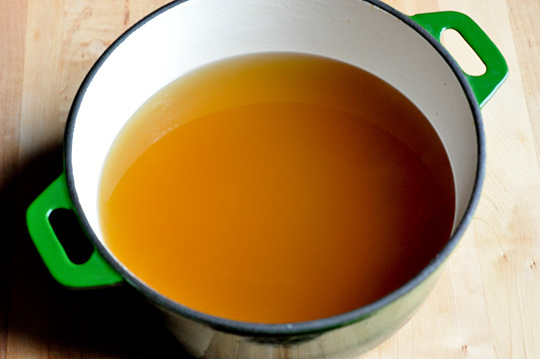Can you cut 1 Tonne of carbon pollution out of your life?
Take the challengeMaking your own vegetable broth or stock is so easy, and you can save kitchen scraps from becoming food waste in the process.
I have been saving my food scraps in the freezer for a couple of weeks now. Onion skins, celery hearts and leaves, spring onion ends and more.
Turns out, these food scraps are not so scrappy after all, and can be used to flavour a simple veggie broth or stock.
So, what's the difference between broth and stock?
Broth, is seasoned, while stock, is not. So the following recipe can be used for both vegetable broth or stock. To make stock, skip adding salt and pepper at the end.
Base ingredients
Your starting point for veggie broth or stock is onions (or a member of the onion family), celery, and carrots. From there, you can tailor your broth to what you're going to be using it for. This is where the veggie scraps come in.
Why should you use kitchen scraps?
Using vegetable peelings, stalks, and leaves can be a great way to save money and avoid wasting food. When we throw away good food, all the nutrients, and energy that went into producing it are lost. It's against all logic to waste food in our world where food insecurity and starvation is a reality for many.
Collect your scraps in a container, freeze them, and when you have a few cups worth, make broth.
There are so many different things you can save. Here are some ideas from the Kitchn:
- Vegetables to use: Onions, carrots, and celery are the key ingredients in vegetable stock, but many other vegetables can add depth and flavor. Wash and save roots, stalks, leaves, ends, and peelings from vegetables such as leeks, scallions, garlic, fennel, chard, lettuce, potatoes, parsnips, green beans, squash, bell peppers, eggplant, mushrooms, and asparagus. Corn cobs, winter squash skins, beet greens, and herbs like parsley and coriander are also good additions.
- Vegetables to avoid: Scraps from the following vegetables are better off going into the compost bin, as their flavors can be too overpowering: cabbage, Brussels sprouts, broccoli, cauliflower, turnips, rutabagas, artichokes.
- Spoiled vegetables: Although stock is a great way to use veggies that are wilted or slightly past their prime, be sure not to use produce that is rotten or moldy.
Note: Beetroots and onion skins will turn your stock red or a yellow/brown, so as long as you don't mind this, feel free to use them.
I made the mistake of using kale stems once, which come from the same family as broccoli. My stock turned out quite bitter. You would probably be better off using kale stems in this delicious pesto.
Close the loop
Since we are making vegetarian stock, you can still compost the vegetables after straining out the stock. More on composting here.

Ingredients
- 1 tablespoon olive oil
- 5 cloves garlic, minced
- 2 large onions, chopped
- 3 ribs celery, chopped
- 3 carrots, chopped
- 8 cups water
- Frozen vegetable scraps (2-3 cups is a good amount)
- 2 bay leaves
- A few sprigs of parsley and thyme
- Salt and pepper to taste (omit these if you're making stock)
Instructions
- Heat the olive oil in a large stockpot over medium heat.
- Add the garlic, onions, celery, and carrots. Cook until softened, about 5 minutes, stirring often.
- Add the water, frozen vegetable scraps, bay leaves, parsley, and thyme.
- Reduce heat to low and simmer, partially covered, for 45 minutes.
- Pour the broth through a fine mesh strainer into a large heat-proof bowl or pot; put solids aside (can compost these later).
- Once the broth has cooled, transfer it to airtight plastic containers and store it in the freezer.
Tip: Freeze in smaller portion sizes so you don't need to thaw everything each time you need broth. Even ice cube trays can be used.
Do you have any tips for making broth or stock using scraps? Leave your comments below!

